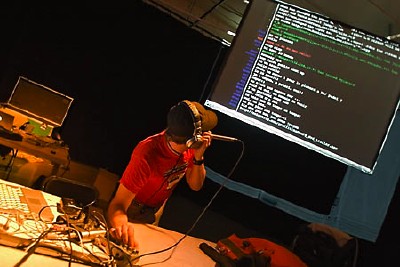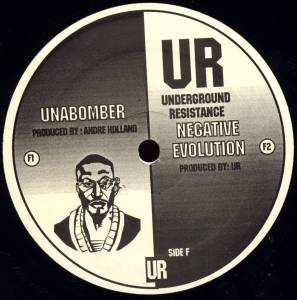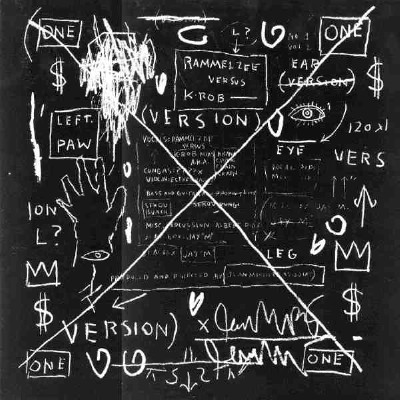 AUTOSEVOCOM TACSAT & AFROFUTURISM [burners & aporias]
AUTOSEVOCOM TACSAT & AFROFUTURISM [burners & aporias]

For those in NYC _, greetings! I see your fair vertical urbanscape soon...
Upgrade! New York :: tobias c. van Veen + Trace Reddell :: Friday, Nov 10, 7:30 PM :: Eyebeam, 540 W. 21st Street, (bet 10th & 11th Ave).

tobias c. van Veen and Trace Reddell will perform and discuss their new audio works. tobias will be poking his head into the aether of the airwaves to perform a short interpretation of AUTOSEVOCOM TACSAT and will give a taste of the as-yet unreleased audiowork FOIL.
AUTOSEVOCOM TACSAT explores surveillance frequencies of encoded police channels against a backdrop of low-end sound composed from fragments of real and virtual war-torn landscapes.
FOIL. A blend of urban recordings from a peaceful Western city with its modernist though unpeaceful counterpart in Beirut falls prey to explosive interventions in EA's BattleField 2 online wargame, eventually detonating itself into the debris of alterity.
Trace will be performing his new live cinema work, “somaticosmos.” In the "somaticosmos," cosmic dissonances intersect with bodily pulse and flow, situating human experience within a barometer of galactic conditions. Noisy space transmissions give way to lush and alien terrains, occasionally disrupted by streams of microscopic rhythms and staticky beats. The visual performance melds the techniques of live VJ projections and digital lumia with the cosmic cinema of Jordan Belson.
tobias c. van Veen is doctoral candidate in Philosophy & Communication Studies at McGill University and a practitioner of the technology arts. He is contributing editor at FUSE and Concept Engineer at La Société des arts technologiques (SAT), where he curates Upgrade Montréal. Since 1993 he has disseminated work in sound, radio & net-art, performing and intervening with laptop and turntables, renegade soundsystems and interventions of inscription [controltochaos.ca]. His writing has been disseminated worldwide. He also mixes a mean absynthe martini [quadrantcrossing.org/blog].
Trace Reddell is a digital media artist and theorist exploring the interactions of multimedia production, networking technologies, media theory, literary criticism, space rock and ambient music, and the history of drug cultures. Over the past two years, Trace's live cinema performances and video works have screened at over thirty international venues, and his net.art and audio projects have appeared regularly on the Web since 1999. Trace is Assistant Professor of Digital Media Studies at the University of Denver, and the graduate director of the M.A. in Digital Media Studies. He founded Denver’s first digital media festival, A:D:A:P:T, in Spring 2003 at Denver’s Museum of Contemporary Art. He edits the “music/sound/noise” content at Electronic Book Review and is the producer of Alt-X Audio.
Upgrade! is an international network of gatherings concerning art + tech + community.
[ turbulence.org on the news ] / [ eyebeam's blurb ]
.... .... .... ... ___ ___ ... ... __ ..__ ...
+++ I'll also be giving a talk entitled TYPEFIGHTER WRITER/TYPEWRITER FIGHTER @ SLSA 2006 on Saturday as Chair of a panel I organised on AfroFuturism, with Trey Conner and Marcel O'Gorman at the Steinhardt Auditorium, Barney Education Building, 34 Stuyvesant St, just off eastside Washington Square, NYU, 2-3:30pm, Saturday November 11th 2006.
.... .... .... ... ___ ___ ... ... __ ..__ ...

["Negative
Evolution" from UR's Interstellar Fugitives LP
(1998)]
+++++++++++++++++++++++++++
Negative Evolution: AfroFuturisms*
STREAM: Music/Sound/Noise of EBR.com
Chair: tobias c. van Veen, McGill University
=======
"Futurism" is often associated with the 20th Century's Italian and Russian avant-garde, and with ambiguously fascist and communist approaches to imagining futurity and technology respectively. Are there other futurisms and has futurism evolved - or critically devolved - from these influential perspectives? A complex relation to these earlier "futurisms" is found in "AfroFuturism." AfroFuturism loosely articulates a broad spectrum of practices, discourses and philosophies - literature, music, science, writing, politics - tied to the technological imaginaries of the black diasporia and, significantly, beyond. In this panel we examine the technoshamanism of jazz in John Coltrane, RAMM:ELL:ZEE's graffiti sign-systems, and the decay of Detroit in relation to the constraints of digital rhetoric.
* "Negative Evolution" title provided by Underground Resistance, Detroit.
--- [1]
FROM COMMUNICATION TO COMMONS-FORMATION:
COLTRANE'S COSMIC MODEL OF RHYTHMIC EN-TRANE-MENT
Trey Conner, Pennsylvania State University
=====
"Once you become aware of this force for unity in life, you can't ever forget it. It becomes part of everything you do. In that respect, [Meditations] is an extension of A Love Supreme since my conception of that force keeps changing shape." –John Coltrane
During 1965, John Coltrane's musician collectives reguarly and seemingly summarily summoned a spectacular resonance. When Coltrane's ensembles sampled from Eastern sacred traditions, they remixed the jazz ensemble playback format, troping it towards one of the oldest genres of information compression, the mantra. A Love Supreme, "Evolution," "Cosmos," Om, and Meditations are at once information compression algorithms and, at the same time, a sequence of sonic snapshots that regulate and transduce Coltrane's cosmic " force of unity," which, nevertheless, like Shiva's dance, always changes--a force that shamanistic practices of rhythm continue to manage and make share-able.
The rich harmonics and affective penumbra produced by mantric formulae, such as Om, opens up more than....well, more than words can say, semantically speaking. This "irrational" quality provokes our deepest feelings and makes it necessary and possible to resonate with others. Coltrane's experiments continue to provide a model for diverse media ecologies moving from communciation to commons-formation, and as such, can help us tune in on the role of rhythm in technocultural production. Jazz has always mixed idioms; increasingly, the discontinuities of digital culture facilitate asignifying mixtures of sacred, secular, and profane technologies. Diverse rhetorics emerge in these digital attention economies in order to describe and participate in these evolutionary dynamics.
tags/keywords: music noise sonic_computing neurobiology evolution rhythmic_entrainment AfroFuturism
--- [2]
DETROIT DEVOLUTION: MEMOIRS OF A TOURIST IN THE APOCALYPSE
Marcel O'Gorman, University of Detroit Mercy
=====
Detroit, Michigan -- burned out, abandoned, and in rapid decay -- is the post-industrial city par excellence. But of course we all know this because Detroit, America’s urban apocalypse, has played host to a multitude of tragedy tourists. These post-urban colonizers, from the out-of-state graffiti artists looking for fresh walls, to the suburban DJ’s hosting dance parties in empty automotive plants, are eager to capitalize on the city’s empty spaces and sublime ruins. And then there’s the Detroit digerati: bloggers and flickr feeders who gather the city’s remains piece by piece and post them as digital curiosities for a global audience. Detroit, like a VHS library, is a devolving archive begging urgently for a remix. But blogging and sampling--even the sampling of that genre known as Detroit Techno--don’t save a city.
In this presentation, Detroit Techno will play backbeat to a sampling of texts and images from America’s urban apocalypse. What I hope to demonstrate is nothing less than the constraints of cyberculture, or more precisely, of digital rhetoric. I will argue that the unwillingness of digital culture to “ground itself,” to embrace the finitude of the body, to choose place over space, leads us headlong into esotericism, devolution, entropy. I will conclude by examining an urban ecology movement that acknowledges this disembodied carnival, but grounds it in the materiality of lived space.
Keywords: devolution, Detroit, techno music, electronica, Graffiti, disembodiment, urbanism, planning, architecture
--- [3]
TYPEFIGHTER WRITER / TYPEWRITER FIGHTER (BURNERS & APORIAS)
tobias c. van Veen, McGill University
=====
RAMM:ELL:ZEE first exhibited his graffiti sign-systems in 1974 on NYC's trains, "the biggest distribution gallery for any art form known to man." Shortly thereafter, Ramm elevated WildStyle tags ("burners"), into IKONOKLAST PANZERISM ("Wild Style Corrected"), taking as his inspiration 10th-15th century European monks and their "MEDIEVAL MECHANISM" of armouring letter-carriers [1]. Meanwhile, in Montreal, Jacques Derrida elevated (if we can play a sample) "the question concerning technology," taking as his inspiration the aporias of language in signalling an "increasingly powerful historical expansion of a general writing," of which truth, presence, consciousness and other themes of metaphysics would be "effects" [2]. This paper seeks to demonstrate how RAMM:ELL:ZEE enters the equation - "equations have no parents" - at the closure of philosophy and the revolution of AfroFuturism... and to investigate the world of Gothic Futurism as it inscribes its "interplanetary" signs.
[1] "Ionic Treatise," GothicFuturism.com & "Rammellzee Interview."
[2] "Signature Event Context," in Limited Inc., Evanston: Northwestern UP, 2000, p. 20.
+++++

[RAMM:ELL:ZEE
& K-Rob's Beat Bop 12", cover by Jean-Michel
Basquiat]
posted. Wed - November 8, 2006 @ 10:07 AM |
..ziP:
./them.hallucinates./.
.this blog sketches patterning / [tV] -- everything here is in-progress, often a mess of thoughts and poorly edited grammar.


2005.projekts
- [NYE] in MTL.
- [11.1o-14.o5] SLSA Chicago.
- [11.o3.o5] Upgrade! Montreal @ SAT
- [1o.13.o5] control.to.chaos djing @ Saphir w/ Fishead et Level 4 Productions.
- [o0.26.o5] Beat Research, Boston. [dj set].
- [o9.24/25.o5] Upgrade International Gathering, NYC @ Eyebeam.
- [o9.22.o5] The Upgrade! Montreal, @ SAT, 18h00-24h00, DONATION. Benefit for Critical Art Ensemble & Robert Ferrell with Artivistic & [CRTL] conferences.
-[o9.21.o5] Where's the Beat, CKUT 90.3FM, Montreal.
- [o9.o1.o5] Cabanon Artivistic Fundraiser / controltochaos.ca w/ FISHEAD dj set + others. | MTL, 2025 St. Laurent.
- [o8.26.o5] (()) : a series of live micro-amplified electronic performances in local studios. live set w/ tomas phillips, john phillips. contact for invite.
- [08.18.05] : FullPleineMoon Party w/ DJ Fishead.
- [o7.28.o5] The Upgrade! Montreal, @ SAT, 18h00-22h00, FREE. Featuring in & out of the studio conference artists.
- [o6.23.o5] The Upgrade! Montreal, @ SAT, 18h00-22h00, FREE.
- [o6.21.o5] Full Moon Party [MTL] w/ Jon Vaughn + Carrie Gates (SK). e for invite.
- [o5.18.o5] Doublethink - Orwell/Huxley NFB Happening [MTL]: performance of the Punishment Intensive SoundSystem (PISS) with Fishead and Black Market LIVE. Performance art, Bioteknica, Hate Orgies, competition debating. e for details.
- [o5.o7-o8.o5] THE SINUES OF THE PRESENT: GENEALOGIES OF BIOPOLITICS @ Universite de Montreal. Plenary speakers: Brian Massumi, Natalie Jeremijenko, Bioteknica. On a panel w/ Nick Dyer-Witheford. Should be interesting.
- [o5.o5.o5] mix_Sessions MDCN: mobile music @ SAT, 22h00-24h00, djing with colin the mole & VJ Beewoo.
- [o5.o5.o5] The Upgrade! Montreal, @ SAT, 18h00-22h00, FREE. With SonicScene / MDCN artists.
- [o5.o5-o8.o5] MDCN Symposium @ SAT.
- [o4.19.o5] The Upgrade! Montreal, @ SAT, 18h00-22h00, FREE. w/ Alain Thibault, Elektra.
- [o3.17.o5] The Upgrade! Montreal, @ SAT, 18h00-22h00, FREE.
- [o2.17.o5] The Upgrade! Montreal, @ SAT, 18h00-22h00, FREE.
- [01.20.05] The Upgrade! Montreal, @ SAT, 18h30-23h00, FREE.
- [12.31.04/05] NYE. email me for details.. djing [vancouver]. [maybe?].
archival.projekts: 1994-2004
- [11.1o-14.o5] SLSA Chicago.
- [11.o3.o5] Upgrade! Montreal @ SAT
- [1o.13.o5] control.to.chaos djing @ Saphir w/ Fishead et Level 4 Productions.
- [o0.26.o5] Beat Research, Boston. [dj set].
- [o9.24/25.o5] Upgrade International Gathering, NYC @ Eyebeam.
- [o9.22.o5] The Upgrade! Montreal, @ SAT, 18h00-24h00, DONATION. Benefit for Critical Art Ensemble & Robert Ferrell with Artivistic & [CRTL] conferences.
-[o9.21.o5] Where's the Beat, CKUT 90.3FM, Montreal.
- [o9.o1.o5] Cabanon Artivistic Fundraiser / controltochaos.ca w/ FISHEAD dj set + others. | MTL, 2025 St. Laurent.
- [o8.26.o5] (()) : a series of live micro-amplified electronic performances in local studios. live set w/ tomas phillips, john phillips. contact for invite.
- [08.18.05] : FullPleineMoon Party w/ DJ Fishead.
- [o7.28.o5] The Upgrade! Montreal, @ SAT, 18h00-22h00, FREE. Featuring in & out of the studio conference artists.
- [o6.23.o5] The Upgrade! Montreal, @ SAT, 18h00-22h00, FREE.
- [o6.21.o5] Full Moon Party [MTL] w/ Jon Vaughn + Carrie Gates (SK). e for invite.
- [o5.18.o5] Doublethink - Orwell/Huxley NFB Happening [MTL]: performance of the Punishment Intensive SoundSystem (PISS) with Fishead and Black Market LIVE. Performance art, Bioteknica, Hate Orgies, competition debating. e for details.
- [o5.o7-o8.o5] THE SINUES OF THE PRESENT: GENEALOGIES OF BIOPOLITICS @ Universite de Montreal. Plenary speakers: Brian Massumi, Natalie Jeremijenko, Bioteknica. On a panel w/ Nick Dyer-Witheford. Should be interesting.
- [o5.o5.o5] mix_Sessions MDCN: mobile music @ SAT, 22h00-24h00, djing with colin the mole & VJ Beewoo.
- [o5.o5.o5] The Upgrade! Montreal, @ SAT, 18h00-22h00, FREE. With SonicScene / MDCN artists.
- [o5.o5-o8.o5] MDCN Symposium @ SAT.
- [o4.19.o5] The Upgrade! Montreal, @ SAT, 18h00-22h00, FREE. w/ Alain Thibault, Elektra.
- [o3.17.o5] The Upgrade! Montreal, @ SAT, 18h00-22h00, FREE.
- [o2.17.o5] The Upgrade! Montreal, @ SAT, 18h00-22h00, FREE.
- [01.20.05] The Upgrade! Montreal, @ SAT, 18h30-23h00, FREE.
- [12.31.04/05] NYE. email me for details.. djing [vancouver]. [maybe?].
archival.projekts: 1994-2004
.. @rchives //
XML/RSS feed.me //
numbers that mean little:
absolut numerosity..:
...puplished 0n: Nov 10, 2006 12:33 PM
...puplished 0n: Nov 10, 2006 12:33 PM